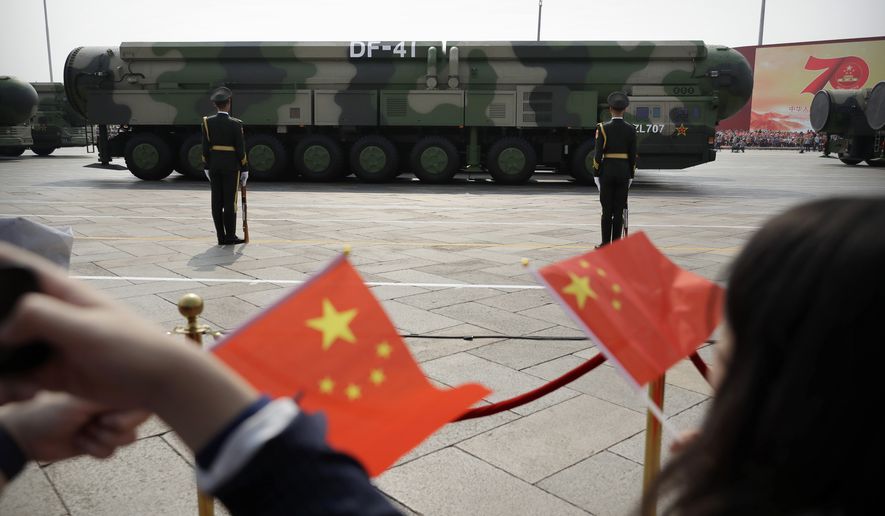China’s military is advancing its nuclear arsenal and delivery systems so fast the Defense Intelligence Agency has had to move up its estimate of when Beijing will double its warhead stockpile, the general in charge of military intelligence told Congress on Thursday.
In wide-ranging testimony, DIA Director Army Lt. Gen. Scott Berrier told a Senate Armed Services Committee hearing on global threats that China and Russia are actively using information warfare surrounding the COVID-19 pandemic to undermine Western governments.
The three-star general said the DIA last year estimated the People’s Liberation Army would double its stockpile of nuclear warheads, which the agency has said was in the “low 200s,” by the year 2030.
“Since then, Beijing has accelerated its nuclear expansion and is on track to exceed our previous projection,” he said. “PLA nuclear forces are expected to continue to grow with their nuclear stockpile likely to at least double in size over this decade and increase the threat to the U.S. homeland.” No new estimate of the number of warheads was made public.
Gen. Berrier said the nuclear buildup is part of a “massive military modernization” by Beijing and is being “accelerated as a deterrent,” he added.
China’s nuclear forces include an array of ground-based mobile missiles, nuclear missile submarines and bombers that provide the Chinese government with a large nuclear force.
On the coronavirus, Gen. Berrier said its origin in China is unclear but DIA analysts believe the initial outbreak began either from infected animals or a laboratory accident. The pandemic will continue until up to 80% of the global population will either be infected or vaccinated, he predicted, and “several countries that had successfully slowed transmission are now reporting resurgences.”
So far, 263 COVID-19 vaccines are in development worldwide, and Gen. Berrier said both China and Russia are engaged information warfare programs during the pandemic “to undermine Western governments, attack coalitions and compel economic and political outcomes in their favor.”
China has attempted to divert international attention from its handling of early days of the pandemic outbreak in 2019 and 2020 by claiming the virus may have originated outside the country, including possibly at a U.S. Army laboratory.
Russia has sought to undermine public confidence in the effectiveness of U.S. vaccines through disinformation campaigns.
On the nuclear front, China is diversifying its arsenal with various weapons and systems in addition to increasing numbers, Gen. Berrier stated. The buildup grew out of military exercises that helped commanders understand which options-provide the most viable nuclear capabilities in the shortest amount of time.
The production speed up was mandated under a Chinese Communist Party communique issued in October 2020, which outlined plans for creating what the general described as “high-level strategic deterrence.”
Gen. Berrier said DIA analysts assess that China is working to narrow the gap in the U.S. qualitative edge in nuclear forces, or to either match or exceed U.S. capabilities.
China is also about to complete deployment for the first time of a nuclear triad with a new strategic bomber that will fire air-launched ballistic missiles, he said.
For submarines, Beijing has fielded six second-generation ballistic missile submarines that will be capable of doing continuous at-sea deterrent patrols with missiles that can strike the United States from areas of the South China Sea.
Gen. Berrier said the new DF-17 hypersonic cruise missile also could be outfitted with a nuclear warhead.
“That poses a significant risk,” he said. “The speed at which those weapons travel makes it very, very difficult to track in their entire trajectory.”
Mark B. Schneider, a nuclear expert with the National Institute for Public Policy and former Pentagon official, said the low 200s warhead estimate is almost certainly too low, considering China’s missile expansion in recent years.
He estimates that the combined nuclear and non-strategic warhead stockpile in China could be as high as 3,000.
“China has traditionally been extremely secretive about its nuclear forces,” he said in a recent article in Real Clear Defense.Mr. Schneider said recent Strategic Command testimony indicates the warhead expansion is the result of deployments of China’s DF-41 missiles, which can carry up to 10 warheads each.
“A major reassessment of China’s nuclear capabilities is long overdue. If China has about 1,000 nuclear warheads in 2030, this would represent a very serious threat. If it already has about 1,000 nuclear warheads today and is increasing that number, this would be even more alarming,” Mr. Schneider said.
Beijing also has placed some of its nuclear forces on a higher alert status that Gen. Berrier described as “launch-on-warning.”
In the past, Chinese warheads had been stored separately from missiles.
The DIA testimony echoed the concerns raised last week in House testimony by Adm. Charles Richard, commander of the Strategic Command, who also warned about what he termed a “breathtaking” Chinese nuclear expansion.
“We are seeing this very rapid expansion of Chinese capabilities,” Adm. Richard said.
The worrying systems include increased numbers of road-mobile intercontinental ballistic missiles, along with many new solid-fueled missiles in silos.
“A solid-fuel rocket is very responsive, and that, coupled with their new nuclear command and control, gives them a launch under warning or launch under attack capability that right now only the U.S. and the Russians possess,” he said.
Adm. Richard said the expansion is so rapid that he informed briefers at Strategic Command that any information on the Chinese nuclear forces that is more than a month old needs to be reassessed.
• Bill Gertz can be reached at bgertz@washingtontimes.com.




Please read our comment policy before commenting.